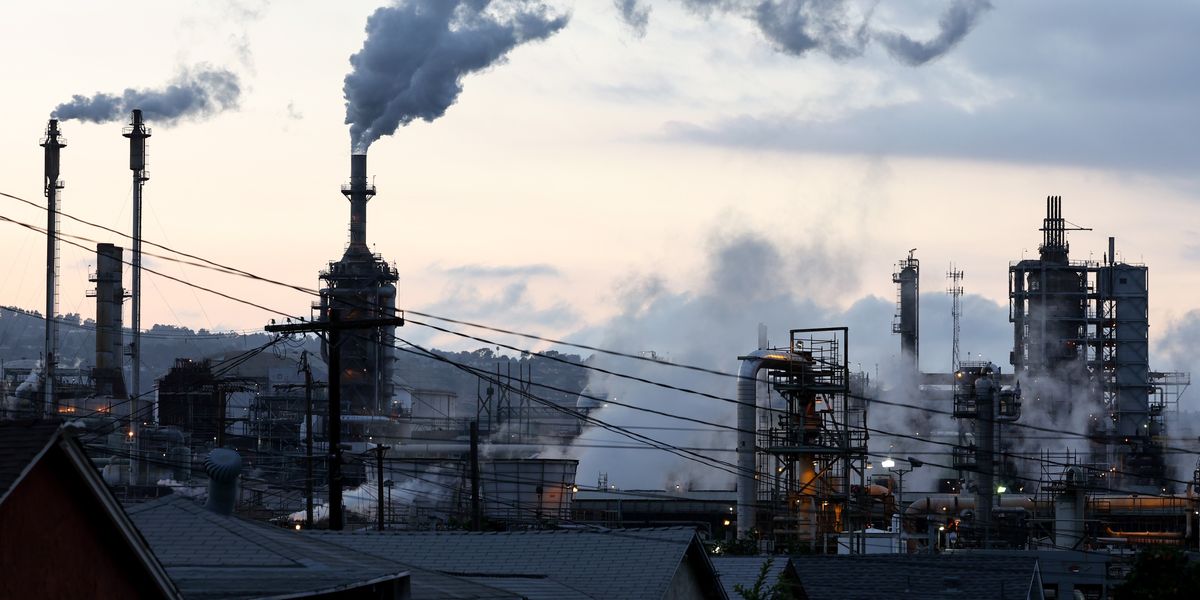Atmospheric Greenhouse Gas Concentrations Hit New Record Levels
Atmospheric Greenhouse Gas Concentrations Hit New Record Levels Common Dreams


Record Levels of Greenhouse Gases Reached in 2023

The three most critical heat-trapping gases in Earth’s atmosphere again reached record levels last year, the U.S. National Oceanic and Atmospheric Administration said Friday, underscoring the inadequacy of efforts to reduce greenhouse gas emissions amid the worsening climate emergency.
Steady Climb of Greenhouse Gases
NOAA said the three most important human-caused greenhouse gases—carbon dioxide (CO2), methane, and nitrous oxide—”continued their steady climb during 2023.”
While the levels of these heat-trapping gases did not rise “quite as high as the record jumps observed in recent years,” the figures “were in line with the steep increases observed during the past decade.”
“We’re caught between a rock and a charred place.”
CO2 Concentrations
Global surface CO2 concentrations averaged 419.3 parts per million (ppm) last year, an increase of 2.8 ppm. It was the 12th straight year in which worldwide CO2 concentrations rose by more than 2 ppm.
Methane and Nitrous Oxide
Atmospheric methane—which while not as abundant as CO2 is up to 87 times more potent over a 20-year period—increased by 10 parts per billion (ppb) to 1,922.6 ppb, while nitrous oxide rose by 1 ppb to 336.7 ppb.
“As these numbers show, we still have a lot of work to do to make meaningful progress in reducing the amount of greenhouse gases accumulating in the atmosphere,” Vanda Grubišić, director of NOAA’s Global Monitoring Laboratory, said in a statement.
Sustainable Development Goals and Climate Change
- SDG 7: Affordable and Clean Energy
- SDG 11: Sustainable Cities and Communities
- SDG 13: Climate Action
- SDG 14: Life Below Water
- SDG 15: Life on Land
According to NOAA:
The amount of CO2 in the atmosphere today is comparable to where it was around 4.3 million years ago during the mid-Pliocene epoch, when sea level was about 75 feet higher than today, the average temperature was 7°F higher than in pre-industrial times, and large forests occupied areas of the Arctic that are now tundra.
About half of the CO2 emissions from fossil fuels to date have been absorbed at the Earth’s surface, divided roughly equally between oceans and land ecosystems, including grasslands and forests. The CO2 absorbed by the world’s oceans contributes to ocean acidification, which is causing a fundamental change in the chemistry of the ocean, with impacts to marine life and the people who depend on [it]. The oceans have also absorbed an estimated 90% of the excess heat trapped in the atmosphere by greenhouse gases.
“Methane’s decadal spike should terrify us,” Rob Jackson, a Stanford University climate scientist who heads the Global Carbon Project—which tracks global emissions but wasn’t part of the NOAA effort—toldNBC News.
“Fossil fuel pollution is warming natural systems like wetlands and permafrost,” Jackson added. “Those ecosystems are releasing even more greenhouse gases as they heat up. We’re caught between a rock and a charred place.”
SDGs, Targets, and Indicators
| SDGs | Targets | Indicators |
|---|---|---|
| SDG 13: Climate Action | 13.1 Strengthen resilience and adaptive capacity to climate-related hazards and natural disasters | Indicator: Increase in global surface CO2 concentrations |
| 13.2 Integrate climate change measures into national policies, strategies, and planning | Indicator: Increase in atmospheric methane and nitrous oxide levels | |
| 13.3 Improve education, awareness-raising, and capacity on climate change mitigation, adaptation, impact reduction, and early warning | No specific indicators mentioned in the article | |
| 13.a Implement the commitment undertaken by developed-country parties to the United Nations Framework Convention on Climate Change to a goal of mobilizing jointly $100 billion annually by 2020 from all sources to address the needs of developing countries in the context of meaningful mitigation actions and transparency on implementation and fully operationalize the Green Climate Fund through its capitalization as soon as possible | No specific indicators mentioned in the article | |
| 13.b Promote mechanisms for raising capacity for effective climate change-related planning and management in least developed countries and small island developing States, including focusing on women, youth, and local and marginalized communities | No specific indicators mentioned in the article | |
| SDG 15: Life on Land | 15.1 By 2020, ensure the conservation, restoration, and sustainable use of terrestrial and inland freshwater ecosystems and their services, in particular forests, wetlands, mountains, and drylands, in line with obligations under international agreements | Indicator: Impact of CO2 absorption by oceans on ocean acidification and marine life |
| 15.2 By 2020, promote the implementation of sustainable management of all types of forests, halt deforestation, restore degraded forests, and substantially increase afforestation and reforestation globally | No specific indicators mentioned in the article |
1. Which SDGs are addressed or connected to the issues highlighted in the article?
SDG 13: Climate Action
The issues highlighted in the article are directly connected to SDG 13, which focuses on taking urgent action to combat climate change and its impacts.
SDG 15: Life on Land
The article also indirectly relates to SDG 15, which aims to protect, restore, and promote sustainable use of terrestrial ecosystems, including forests.
2. What specific targets under those SDGs can be identified based on the article’s content?
SDG 13: Climate Action
– Target 13.1: Strengthen resilience and adaptive capacity to climate-related hazards and natural disasters.
– Target 13.2: Integrate climate change measures into national policies, strategies, and planning.
– Target 13.3: Improve education, awareness-raising, and capacity on climate change mitigation, adaptation, impact reduction, and early warning.
– Target 13.a: Implement the commitment undertaken by developed-country parties to the United Nations Framework Convention on Climate Change to a goal of mobilizing jointly $100 billion annually by 2020 from all sources to address the needs of developing countries in the context of meaningful mitigation actions and transparency on implementation and fully operationalize the Green Climate Fund through its capitalization as soon as possible.
– Target 13.b: Promote mechanisms for raising capacity for effective climate change-related planning and management in least developed countries and small island developing States, including focusing on women, youth, and local and marginalized communities.
SDG 15: Life on Land
– Target 15.1: Ensure the conservation, restoration, and sustainable use of terrestrial and inland freshwater ecosystems and their services, in particular forests, wetlands, mountains, and drylands, in line with obligations under international agreements.
– Target 15.2: Promote the implementation of sustainable management of all types of forests, halt deforestation, restore degraded forests, and substantially increase afforestation and reforestation globally.
3. Are there any indicators mentioned or implied in the article that can be used to measure progress towards the identified targets?
– Indicator: Increase in global surface CO2 concentrations.
– Indicator: Increase in atmospheric methane and nitrous oxide levels.
– Indicator: Impact of CO2 absorption by oceans on ocean acidification and marine life.
These indicators can be used to measure progress towards the identified targets by monitoring the levels of greenhouse gases in the atmosphere and their impact on climate change and ecosystems.
4. SDGs, Targets, and Indicators
| SDGs | Targets | Indicators |
|---|---|---|
| SDG 13: Climate Action | 13.1 Strengthen resilience and adaptive capacity to climate-related hazards and natural disasters | Indicator: Increase in global surface CO2 concentrations |
| 13.2 Integrate climate change measures into national policies, strategies, and planning | Indicator: Increase in atmospheric methane and nitrous oxide levels | |
| 13.3 Improve education, awareness-raising, and capacity on climate change mitigation, adaptation, impact reduction, and early warning | No specific indicators mentioned in the article | |
| 13.a Implement the commitment undertaken by developed-country parties to the United Nations Framework Convention on Climate Change to a goal of mobilizing jointly $100 billion annually by 2020 from all sources to address the needs of developing countries in the context of meaningful mitigation actions and transparency on implementation and fully operationalize the Green Climate Fund through its capitalization as soon as possible | No specific indicators mentioned in the article | |
| 13.b Promote mechanisms for raising capacity for effective climate change-related planning and management in least developed countries and small island developing States, including focusing on women,
Behold! This splendid article springs forth from the wellspring of knowledge, shaped by a wondrous proprietary AI technology that delved into a vast ocean of data, illuminating the path towards the Sustainable Development Goals. Remember that all rights are reserved by SDG Investors LLC, empowering us to champion progress together. Source: commondreams.org
Join us, as fellow seekers of change, on a transformative journey at https://sdgtalks.ai/welcome, where you can become a member and actively contribute to shaping a brighter future.
|








